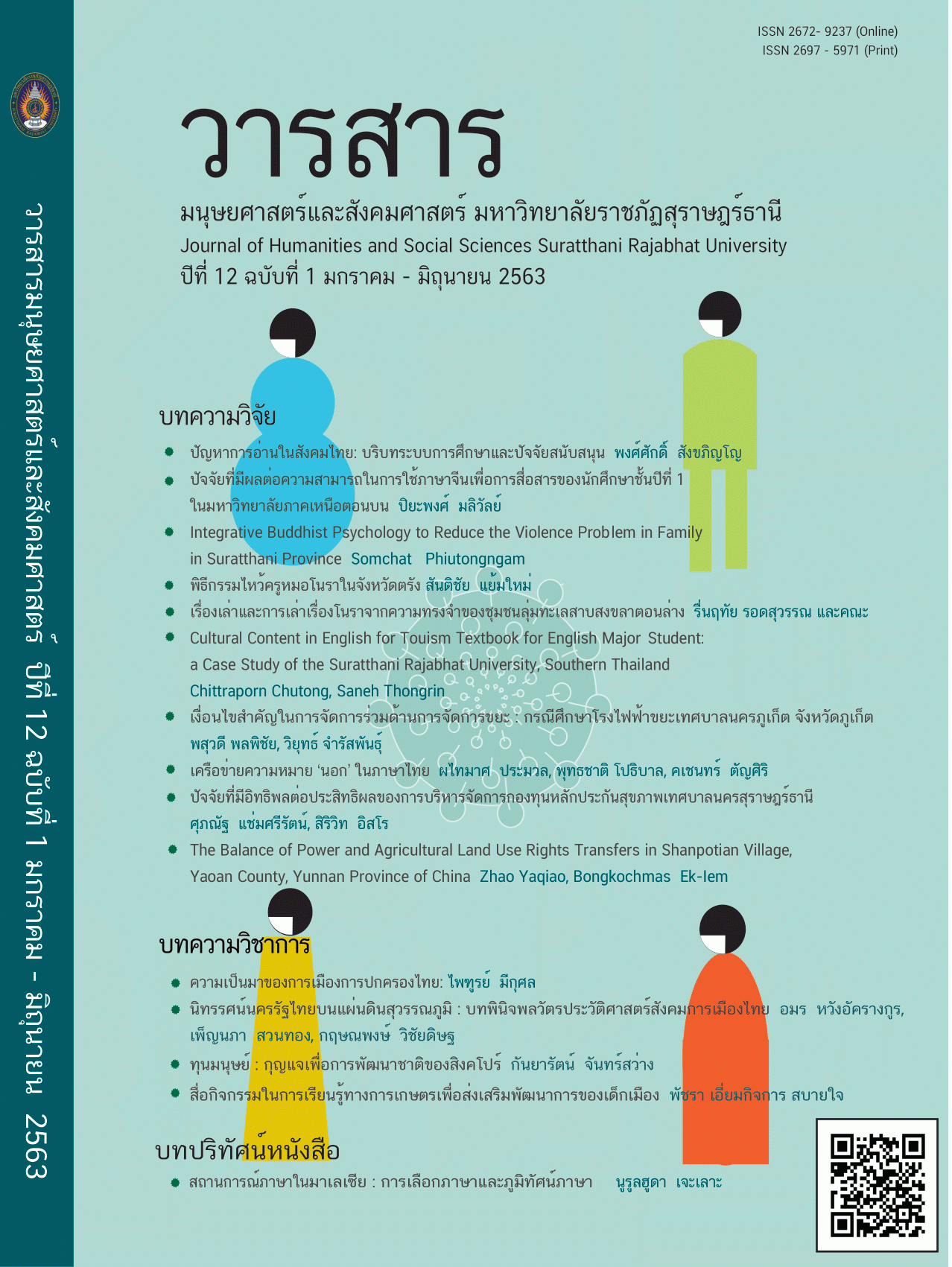Cultural Content in English for Tourism Textbook for English Major Students : a Case Study of Suratthani Rajabhat University, Southern Thailand
Main Article Content
Abstract
The study explores the cultural content of the English tourism textbook used by English major students at Suratthani Rajabhat University. The aim of this study is to investigate what cultures are represented and how cultures are represented in the textbook. The information was gathered from reading passages and images in each lesson in English for a tourism course, written by Thai authors. To reveal what cultures are presented in the textbook, cultural contents are categorized into categories and the themes of culture under Big “C” and little “c”. Findings indicate that the Big "C" culture is the highest source of culture in the target textbook, whereas the little "c" culture is portrayed at a much lower level. The culture categories are presented in the form of Thai culture (Tourism information in Thailand, Thai handicrafts, Tourist attractions in Thailand, Thai food, Thai way of life, Religious ceremony, Thai martial arts, and history of Thailand). International culture is presented in the form of Chinese and German cultures. The finding of cultural content in terms of cultural themes found the seven cultural themes, The most common themes were four themes under Big “C” such as“Economy”, “Geography”, “Architecture” and “History” and three themesunder little “c” cultures such as “Life Style”, “Food”, and “Holidays”. This research may offer some suggestions for the development ofEnglish-language textbooks that are culturally appropriate for languageeducators and learners at universities in Thailand.
Article Details

This work is licensed under a Creative Commons Attribution-NonCommercial-NoDerivatives 4.0 International License.
All published manuscripts have been verified by peer-peer professors in the fields of humanities and social sciences. Reprinting of the article must be authorized by the editorial staff.
References
Adaskou, K., Britten, D., and Fahsi, B. (1990). Design decisions on the
cultural content of a secondary English course for Mororcco. ELT Journal. 44(1). 3-10.
Brown, H. D. (2000). Principles and language learning and teaching (4th ed.).
White Plains, NY: Addison Wesley Longman.
Byrnes, H. (2010). Revisiting the role of culture in the foreign language
curriculum. The Modern Language Journal, 94(2), 335-336. http://
dx.doi.org/10.1111/j.1540-4781.2010.01023.x
Cakir, İ. (2010). The Frequency of Culture-Specific Elements in the ELT
Coursebooks at Elementary Schools in Turkey. Novitas-ROYAL, 4(2),
–189.
Chen B. B. (2004). A survey on cultural learning and its variables analysis.
Xi’an: Journal of Xi’an International Studies University, 12(3), 21-24.
Cortazzi, M., and Jin, L. X. (1999). Cultural mirrors: materials and method in the EFL classroom. In Hinkel, E. (ed.), Culture in Second Language
Teaching (pp. 196-219). Cambridge: Cambridge University Press.
Cunningsworth, A. (1995). Choosing your coursebook. London: Hinemann.
Gómez Rodríguez, L. F. (2015). The cultural content in EFL
textbooks and what teachers need to do about it. PROFILE Issues in
Teachers’ ProfessionDevelopment, 17(2), 167-187.
Dervin, F. (2012). Cultural Identity, Representation and Othering. in J.
Jackson (Ed.). The Routledge handbook of language and intercultural
communication. London: Routledge.
Gomez Rodriguez, L. F. (2015). The cultural content in EFL textbooks and
what teachers need to do about it. PROFILE Issues in Teachers’
Professional Development. 17(2). 167-187.
Hermawan, B. (2012). Traces of Cultures in English Textbooks for Primary
Education. Conaplin Journal Indonesian Journal of Applied
Linguistics. 1(2). 49-61
Kilickaya, F. (2004). Authentic Materials and Cultural Content in EFL
Classrooms. The Internet TESL Journal. 10 (7). 1-5.
Kramsch, C. J. (1993). Context and culture in language teaching. Oxford:
Oxford University Press.
Lee, K. (2009). Treating culture: What 11 high school EFL conversation
textbooks in South Korea do. English Teaching: Practice and
Critique, 8(1), 76–96.
McKay, S. L. (2000). Teaching English as an international language:
Implications for cultural materials in the classroom. TESOL Journal,
(4), 7-11. http://dx.doi.org/10.1002/j.1949-3533. 2000.tb00276.x
McKay, S. L. (2002). Teaching English as International Language: rethinking
goals and approaches. Oxford: Oxford University Press.
Nault, D. (2006). Going Global: Rethinking Culture Teaching in ELT Contexts.
Language, Culture and Curriculum. 19(3). 314-328.
Peterson, B. (2004). Cultural intelligence: A guide to working with people
from other cultures. Yarmouth, ME: Intercultural Press.
Sugirin, Sudartini, S., Suciati, and Nurhayati, L. (2011). A Study on Cultural
Integration in the English Textbooks for Junior High Schools. LITERA.
(2). 235-246.
Syahri, I., and Susanti, R. (2016). An Analysis of Local and Target Culture
Integration in the English Textbooks for Senior High School in
Palembang. Journal of Education and Human Development. 5(2).
-102.
Tomlinson, B. (1998). Materials development in language teaching.
Cambridge: Cambridge University Press.
Wintergerst, A. C., and McVeigh, J. (2010). Tips for teaching culture: A
practical approach to intercultural communication. White Plains, NY: Pearson Longman.
Yuen, K.-M. (2011). The representation of foreign cultures in English
textbooks. ELT Journal: English Language Teaching Journal, 65(4),
–466.


